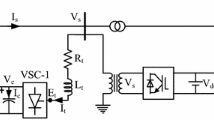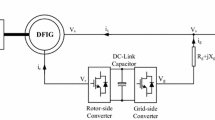Abstract
Low-voltage ride-through is important for the operation stability of the system in balanced- and unbalanced-grid-fault-connected doubly fed induction generator-based wind turbines. In this study, a new LVRT capability approach was developed using positive–negative sequences and natural and forcing components in DFIG. Besides, supercapacitor modeling is enhanced depending on the voltage–capacity relation. Rotor electro-motor force is developed to improve low-voltage ride-through capability against not only symmetrical but also asymmetrical faults of DFIG. The performances of the DFIG with and without the novel active–passive compensator–supercapacitor were compared. Novel active–passive compensator–supercapacitor modeling in DFIG was carried out in MATLAB/SIMULINK environment. A comparison of the system behaviors was made between three-phase faults, two-phase faults and a phase–ground fault with and without a novel active–passive compensator–supercapacitor modeling. Parameters for the DFIG including terminal voltage, angular speed, electrical torque variations and d–q axis rotor–stator current variations, in addition to a 34.5 kV bus voltage, were investigated. It was found that the system became stable in a short time and oscillations were damped using novel active–passive compensator–supercapacitor modeling and rotor EMF.








Similar content being viewed by others
Abbreviations
- K :
-
Gain
- P :
-
Active power (W)
- Q :
-
Reactive power (W)
- V :
-
Voltage (V)
- i :
-
Current (A)
- L :
-
Inductance (H)
- w :
-
Angular speed (m/s)
- DC:
-
Direct current (A)
- LVRT:
-
Low-voltage ride-through
- DFIG:
-
Doubly fed induction generator
- EMF:
-
Electro-motor force
- NAPC:
-
Novel active–passive compensator
- TSO:
-
Transmission system operators
- WT:
-
Wind turbine
- FACTS:
-
Flexible AC transmission system
- STATCOM:
-
Static synchronous compensator
- ESS:
-
Energy storage system
References
Tsili M, Papathanassiou S (2009) A review of grid code technical requirements for wind farms. IET Renew Power Gener 3(3):308–332
Petersson A, Thiringer T, Harnefors L, Petru T (2005) Modeling and experimental verification of grid interaction of a DFIG wind turbine. IEEE Trans Energy Convers 20(4):878–886
Muller S, Deicke M, De Doncker RW (2002) Doubly fed induction generator systems for wind turbines. IEEE Ind Appl Mag 8(3):26–33
Zhu R, Chen Z, Wu X, Deng F (2015) Virtual damping flux-based LVRT control for DFIG-based wind turbine. IEEE Trans Energy Convers 30(2):714–725
Kashkooli MA, Madani SM, Lipo TA (2019) Improved direct torque control for a DFIG under symmetrical voltage dip with transient flux damping. IEEE Trans Industr Electron. https://doi.org/10.1109/TIE.2019.2893856
Hu S, Lin X, Kang Y, Zou X (2011) An improved low-voltage ride-through control strategy of doubly fed induction generator during grid faults. IEEE Trans Power Electron 26(12):3653–3665
Yao J, Li H, Chen Z, Xia X, Chen X, Li Q, Liao Y (2013) Enhanced control of a DFIG-based wind-power generation system with series grid-side converter under unbalanced grid voltage conditions. IEEE Trans Power Electron 28(7):3167–3181
Mohseni M, Masoum MA, Islam SM (2011) Low and high voltage ride-through of DFIG wind turbines using hybrid current controlled converters. Electr Power Syst Res 81(7):1456–1465
Ebrahimkhani S (2016) Robust fractional order sliding mode control of doubly-fed induction generator (DFIG)-based wind turbines. ISA Trans 63:343–354
Xiong L, Li P, Wu F, Ma M, Khan MW, Wang J (2019) A coordinated high-order sliding mode control of DFIG wind turbine for power optimization and grid synchronization. Int J Electr Power Energy Syst 105:679–689
Alsmadi YM, Xu L, Blaabjerg F, Ortega AJP, Abdelaziz AY, Wang A, Albataineh Z (2018) Detailed investigation and performance improvement of the dynamic behavior of grid-connected DFIG-based wind turbines under LVRT conditions. IEEE Trans Ind Appl 54(5):4795–4812
Yang L, Xu Z, Ostergaard J, Dong ZY, Wong KP (2012) Advanced control strategy of DFIG wind turbines for power system fault ride through. IEEE Trans Power Syst 27(2):713–722
Li XM, Zhang XY, Lin ZW, Niu YG (2018) An improved flux magnitude and angle control with LVRT capability for DFIGs. IEEE Trans Power Syst 33(4):3845–3853
Xiao S, Geng H, Zhou H, Yang G (2013) Analysis of the control limit for rotor-side converter of doubly fed induction generator-based wind energy conversion system under various voltage dips. IET Renew Power Gener 7(1):71–81
Liang J, Qiao W, Harley RG (2010) Feed-forward transient current control for low-voltage ride-through enhancement of DFIG wind turbines. IEEE Trans Energy Convers 25(3):836–843
Liang J, Qiao W, Harley RG (2009) Direct transient control of wind turbine driven DFIG for low voltage ride-through. In: Power electronics and machines in wind applications. PEMWA 2009. IEEE, pp 1–7
Chondrogiannis S, Barnes M (2008) Stability of doubly-fed induction generator under stator voltage orientated vector control. IET Renew Power Gener 2(3):170–180
Liao K, Xu Y, Wang Y, Lin P (2019) Hybrid control of DFIGs for short-term and long-term frequency regulation support in power systems. IET Renew Power Gener 13(8):1271–1279
Liu Y, Jiang L, Smith JS, Wu QH (2018) Primary frequency control of DFIG-WTs using bang-bang phase angle controller. IET Gener Transm Distrib 12(11):2670–2678
Yan L, Chen X, Zhou X, Sun H, Jiang L (2018) Perturbation compensation-based non-linear adaptive control of ESS-DVR for the LVRT capability improvement of wind farms. IET Renew Power Gener 12(13):1500–1507
Döşoğlu MK (2017) Enhancement of SDRU and RCC for low voltage ride through capability in DFIG based wind farm. Electr Eng 99(2):673–683
Saeed MA, Khan HM, Ashraf A, Qureshi SA (2018) Analyzing effectiveness of LVRT techniques for DFIG wind turbine system and implementation of hybrid combination with control schemes. Renew Sustain Energy Rev 81:2487–2501
Qiao W, Venayagamoorthy GK, Harley RG (2009) Real-time implementation of a STATCOM on a wind farm equipped with doubly fed induction generators. IEEE Trans Ind Appl 45(1):98–107
Ananth DVN, Kumar GN (2016) Fault ride-through enhancement using an enhanced field oriented control technique for converters of grid connected DFIG and STATCOM for different types of faults. ISA Trans 62:2–18
Abbey C, Joos G (2007) Supercapacitor energy storage for wind energy applications. IEEE Trans Ind Appl 43(3):769–776
Jerin ARA, Kaliannan P, Subramaniam U, El Moursi MS (2018) Review on FRT solutions for improving transient stability in DFIG-WTs. IET Renew Power Gener 12(15):1786–1799
Döşoğlu MK (2016) Hybrid low voltage ride through enhancement for transient stability capability in wind farms. Int J Electr Power Energy Syst 78:655–662
Mohammadi J, Afsharnia S, Vaez-Zadeh S, Farhangi S (2016) Improved fault ride through strategy for doubly fed induction generator based wind turbines under both symmetrical and asymmetrical grid faults. IET Renew Power Gener 10(8):1114–1122
Döşoğlu MK, Güvenç U, Sönmez Y, Yılmaz C (2018) Enhancement of demagnetization control for low-voltage ride-through capability in DFIG-based wind farm. Electr Eng 100:491–498
Döşoğlu MK (2016) A new approach for low voltage ride through capability in DFIG based wind farm. Int J Electr Power Energy Syst 83:251–258
Döşoğlu MK, Arsoy AB, Güvenç U (2017) Application of STATCOM-supercapacitor for low-voltage ride-through capability in DFIG-based wind farm. Neural Comput Appl 28(9):2665–2674
Döşoğlu MK, Arsoy AB (2016) Transient modeling and analysis of a DFIG based wind farm with supercapacitor energy storage. Int J Electr Power Energy Syst 78:414–421
Wu F, Zhang XP, Godfrey K, Ju P (2007) Small signal stability analysis and optimal control of a wind turbine with doubly fed induction generator. IET Gener Transm Distrib 1(5):751–760
Krause PC (2002) Analysis of electric machinery, 2nd edn. McGraw-Hill, New York
Ekanayake JB, Holdsworth L, Jenkins N (2003) Comparison of 5th order and 3rd order machine models for double fed induction generators (DFIG) wind turbines. Electr Power Syst Res 67(3):207–215
Slootweg JG, Polinder H, Kling WL (2001) Dynamic modelling of a wind turbine with doubly fed induction generator. IEEE Power Eng Soc Summer Meet 1:644–649
Mohammadi J, Afsharnia S, Vaez-Zadeh S (2014) Efficient fault-ride-through control strategy of DFIG-based wind turbines during the grid faults. Energy Convers Manag 78:88–95
Mohammadi J, Afsharnia S, Ebrahimzadeh E, Blaabjerg F (2017) An enhanced LVRT scheme for DFIG-based WECSs under both balanced and unbalanced grid voltage sags. Electr Power Compon Syst 45(11):1242–1252
Gaiceanu M (2012) MATLAB/SIMULINK-based grid power inverter for renewable energy sources integration. In: MATLAB—a fundamental tool for scientific computing and engineering applications, pp 1–219
Rona B, Güler Ö (2015) Power system integration of wind farms and analysis of grid code requirements. Renew Sustain Energy Rev 49:100–107
Author information
Authors and Affiliations
Corresponding author
Additional information
Publisher's Note
Springer Nature remains neutral with regard to jurisdictional claims in published maps and institutional affiliations.
Rights and permissions
About this article
Cite this article
Döşoğlu, M.K., Özkaraca, O. & Güvenç, U. Novel active–passive compensator–supercapacitor modeling for low-voltage ride-through capability in DFIG-based wind turbines. Electr Eng 101, 1119–1132 (2019). https://doi.org/10.1007/s00202-019-00857-y
Received:
Accepted:
Published:
Issue Date:
DOI: https://doi.org/10.1007/s00202-019-00857-y




